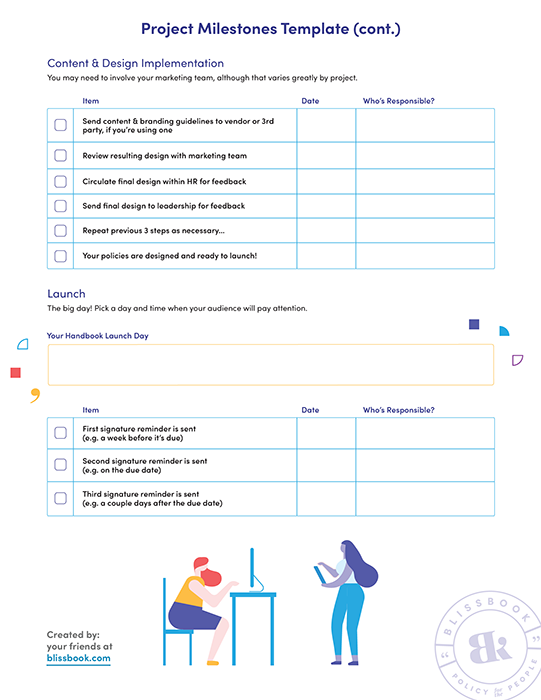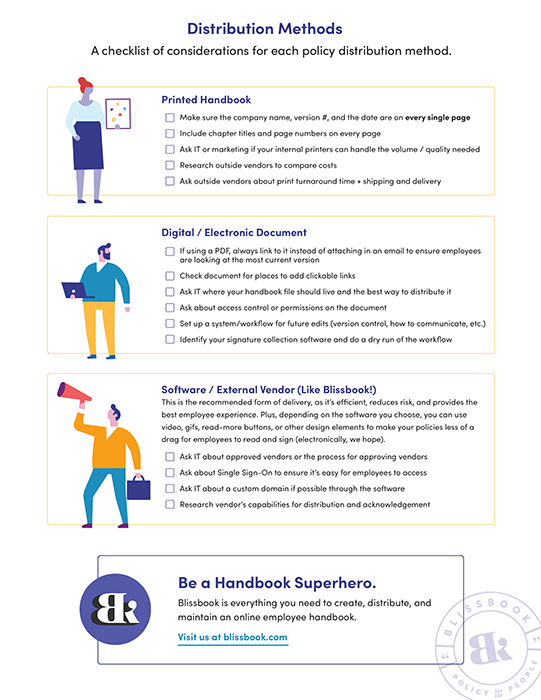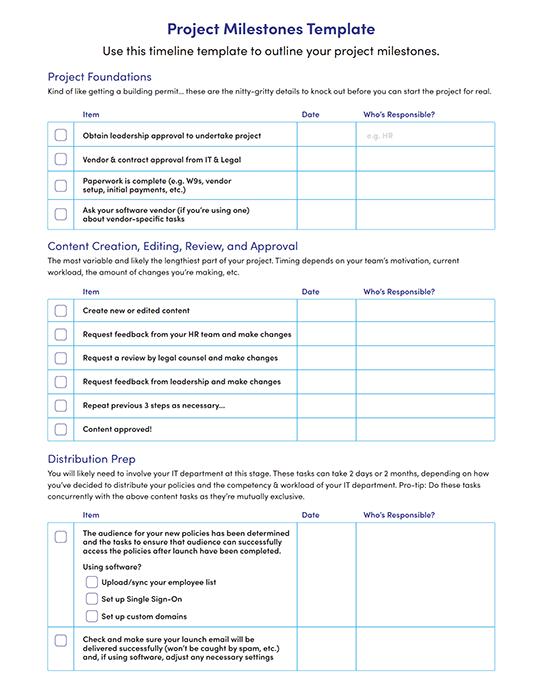How to Write Policies & Procedures
1. The Prep Work
Getting Started with Your Policies and Handbook

As soon as a company has grown beyond the founders, and they’re hiring that first employee, they need to have written policies in place. They need to communicate, “Here’s our culture. Here’s our expectations.”
It’s time to update your employee policies and procedures handbook! Before you curl up into a ball or run for the hills, remember that starting a project tends to be the hardest part. By doing basic prep work before you begin, you will set yourself up for success.
As Lindsey Kucharski, former HR Manager, US & LATAM at Blue Prism, explained “things have changed a lot since the 40-50 page binder.” But, some things are still the same, such as your need to address changes in your industry, in your company, and in the role of a human resources professional.
So, where in the world is Carmen Sandiego do you begin? First, you need to determine the scope of the project you’re undertaking – and go from there. Think big-picture and determine who and what you may need along the way. This includes defining objectives, considering potential roadblocks, deciding who to involve, and developing a project plan to share with stakeholders.
What’s the Goal?
In the wee stages of the project, you’ll want to identify key objectives for updating your policies and procedures. Here are a few common goals... or refer to the first page of your Policies & Procedures Workbook to check your own!
- Your existing policies need a review to ensure they're still compliant with updated laws.
- You're revamping policies such as parental leave, remote working, data privacy, or others to achieve business goals.
- You’re hoping to better express your employer brand & company culture during onboarding.
- You're updating legal-speak (read: boring) policies to make them more interactive and friendly for employees.
- Your company is going digital and it’s a good time to review your content.
Case Study: Handling Multiple Locations
Bringing employees from all locations and divisions “together as one company” was Chanin’s main goal and challenge. She needed a set of policies and procedures that supported the company as a whole and communicated who they were regardless of where an employee worked (across multiple states). Her team standardized many policies and then used Blissbook's personalized content feature to tailor specific content to specific audiences.

Chanin Christensen
SVP / HR Manager at Merrick Bank

As you list out your objectives, consider any potential roadblocks that could occur:
- Does a new change to a law significantly impact any of your policies?
- Do your benefits need to be updated?
- Will certain teams or departments be affected, and, if so, might they push back on the new policies?
- Do you need budget approval for new software, legal support, or additional staff support?
- Do you need leadership approval to even start the project?
By proactively considering obstacles, you can be prepared for challenges when they arise.
Consider what happens after your new policies achieve those goals, as well.
How will you handle ad-hoc changes? It’s easy to plan for things that happen cyclically, like benefits enrollment, but what about an employment law change at the federal or state level?
How will you update, distribute, and obtain acknowledgement from all of your employees? This includes reminding 25+% of employees who ignore your initial request for acknowledgement.
How will you manage an audit to determine your company’s compliance with federal and state laws or a specific IT certification (e.g. SOC 2)?
Ideally, you can conquer your objectives while establishing a process that satisfies your future needs. By investing the time now to consider eventual what-if scenarios, you can save your company (and yourself) a lot of frustration.
What Tools are Available?
Updating your policies and procedures can be a daunting task, so technology can be a life-saver. Consider investing in software that helps you get through creation, review, publication, and distribution.
Helpful Tools for Policies and Procedures:
- Collaboration tools for sharing, reviewing, and commenting on content
- Project management software
- Secure delivery software that allows for tracking reviews
- E-Signature software
- Photography, illustrations, and video
- Survey software to engage with employees
By taking care of these tasks early, you’ll set yourself up to have what you need when you need it – including the support of people inside or outside your company.

Be a Handbook Superhero.
Blissbook is everything you need to create, distribute, and maintain an online employee handbook.
Request a DemoWhat’s Trending?
A little friendly research will provide insight into what others are doing and, more importantly, what will best align with your company and values. Research also keeps your company competitive in an ever-evolving job market. By staying familiar with the latest trends and offerings, you can confidently propose changes to established policies while providing a fail-proof rationale: everybody’s doing it; we’re actually behind the times.
Case Study: Data Hunt
Lindsey Kucharski wanted to recommend unlimited PTO for two of their locations, so she looked for data from other similar companies. She used that data to demonstrate that unlimited PTO was a fairly common practice within their industry, so a change to the PTO policy would help them attract and retain the best talent.

Lindsey Kucharski
Former Global HR Business Partner & HR Manager at Blue Prism

Great Resources for Up-to-Date Research:
The California Law Certification Program offered by SHRM was recommended by Jeni Strand, Senior VP of HR at AgCountry, as a great resource for anyone wanting to learn more about some of the most employee-friendly laws in the country.
Interview Your Employees
Employee interviews can provide a look into their perspective, offering another source of research. Engage members of marketing, recruiting, leadership, and other teams to develop a better idea of key culture-oriented messages. Evaluate the perception of your employer brand, considering the following questions:
- How do your employees, customers, vendors, and suppliers view your company?
- What's a new candidate's perception of your company?
- What nouns, verbs, and adjectives are used to describe your company?
- How can you interweave culture-focused messages into the guide to break up sections that may be lengthy or otherwise (*yawn*) uninteresting?
- Can you include inspiring quotes, statistics or fun facts to inject some life while underscoring a key policy?
If you don’t have time to conduct interviews or if you’d like a broader viewpoint from many people in your company, you can always try a survey.
Case Study: FAMILY LEAVE STUDY
Jeni Strand used a survey to learn more about employee needs, particularly relating to family leave. When she got the results back, it became clear that the company needed to build a policy that would better serve employees, whether they were welcoming a new baby or caring for aging parents.

Jeni Strand
Senior VP HR at AgCountry

After outlining your objectives, identifying useful resources and orgCollaborators, and evaluating the current landscape within your company and beyond, it’s time to start planning.


